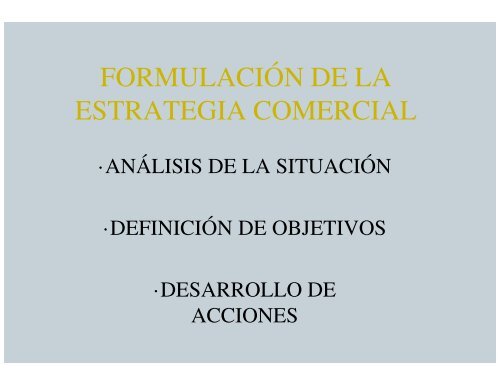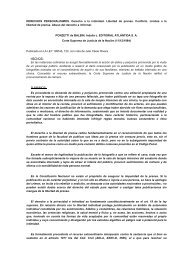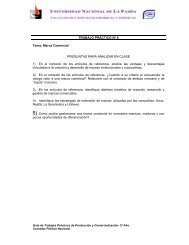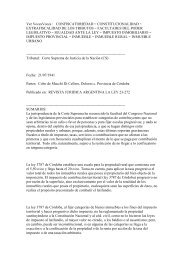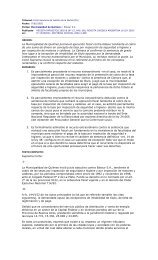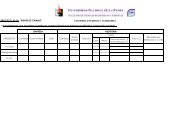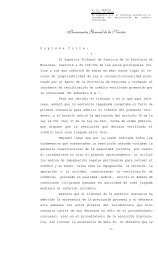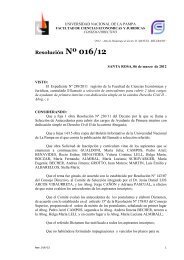FORMULACION DE LA ESTRATEGIA COMERCIAL CON ...
FORMULACION DE LA ESTRATEGIA COMERCIAL CON ...
FORMULACION DE LA ESTRATEGIA COMERCIAL CON ...
Create successful ePaper yourself
Turn your PDF publications into a flip-book with our unique Google optimized e-Paper software.
ANÁLISIS <strong>DE</strong> <strong>LA</strong> SITUACIÓN• <strong>DE</strong>FINICIÓN <strong>DE</strong> <strong>LA</strong> EMPRESA Y <strong>DE</strong>LPRODUCTO/MERCADO• ANÁLISIS <strong>DE</strong>L MERCADO• ANÁLISIS <strong>DE</strong>L ENTORNO• ANÁLISIS <strong>DE</strong> <strong>LA</strong> COMPETENCIA• ANÁLISIS INTERNO <strong>DE</strong> LOS RECURSOS YCAPACIDA<strong>DE</strong>S
<strong>DE</strong>FINICIÓN <strong>DE</strong> <strong>LA</strong> EMPRESA• ¿CUÁL ES <strong>LA</strong> MISIÓN <strong>DE</strong> <strong>LA</strong> EMPRESA?• ¿EN QUÉ NEGOCIO ESTÁ <strong>LA</strong> EMPRESA?• ¿CUÁL ES EL PRODUCTO O CARTERA <strong>DE</strong>PRODUCTOS QUE VEN<strong>DE</strong>?• ¿A QUÉ MERCADO SIRVE?• ¿CUÁLES SON LOS SEGMENTOSPRIORITARIOS?
MISIÓN <strong>DE</strong> <strong>LA</strong> EMPRESASE <strong>CON</strong>FIGURA POR:• SU HISTORIA• <strong>LA</strong>S PREFERENCIAS ACTUALES• LOS FACTORES <strong>DE</strong>L ENTORNO• LOS RECURSOS <strong>DE</strong> <strong>LA</strong> ORGANIZACIÓN• <strong>LA</strong>S VENTAJAS COMPETITIVAS
ANÁLISIS <strong>DE</strong>L MERCADO<strong>DE</strong>TERMINACIÓN <strong>DE</strong>:• TAMAÑO• POTENCIAL• <strong>LA</strong> ESTRUCTURA <strong>DE</strong>L <strong>CON</strong>SUMO• <strong>LA</strong> CAPACIDAD <strong>DE</strong> COMPRA• LOS SEGMENTOS QUE LO COMPONEN• EVOLUCIÓN <strong>DE</strong> <strong>LA</strong> <strong>DE</strong>MANDA
ANÁLISIS <strong>DE</strong>L ENTORNO• CAPACIDAD <strong>DE</strong> ADAPTACIÓN• CAMBIOS <strong>DE</strong>L ENTORNO:– ¿AMENAZAS? ANTICIPARSE O REACCIONAR– ¿OPORTUNIDA<strong>DE</strong>S? APROVECHAR
ANÁLISIS <strong>DE</strong> <strong>LA</strong>COMPETENCIA Y <strong>DE</strong>L SECTOR• I<strong>DE</strong>NTIFICACIÓN <strong>DE</strong> LOS COMPETIDORESACTUALES Y POTENCIALES• OBJETIVOS <strong>DE</strong> LOS COMPETIDORES• PUNTOS FUERTES Y DÉBILES <strong>DE</strong> LOSCOMPETIDORES
ANÁLISIS INTERNO <strong>DE</strong> LOSRECURSOS Y CAPACIDA<strong>DE</strong>S• <strong>DE</strong>TERMINACIÓN <strong>DE</strong> SUS PUNTOS• <strong>DE</strong>TERMINACIÓN <strong>DE</strong> SUS PUNTOSFUERTES Y DÉBILES
<strong>DE</strong>FINICIÓN <strong>DE</strong> LOS OBJETIVOSOPCIONES ESTRATÉGICASINNOVAROBTENER VENTAJA COMPETITIVAINCREMENTAR <strong>LA</strong> PARTICIPACIÓN<strong>DE</strong>L MERCADOMEJORAR <strong>LA</strong> RENTABILIDAD
OBJETIVOS <strong>DE</strong> MARKETINGResponden a una situación determinada en elanálisis FODA. No son resultado de lacreatividad, sino que se originan en situacionesmuy específicas.Siempre son específicos. No tratan asuntosgenerales del área.Su plazo es de un año: en términos generalesel plan se elabora en forma anual.Buscan evitar el canibalismo. No debeninterferir en el desarrollo de otra marca oproducto
CARACTERÍSTICAS <strong>DE</strong> LOS OBJETIVOSAlcanzables: es decir, debe existir la posibilidad delograrlo.Temporales: Debe tener una fecha de inicio y determinación.Medibles: Debe incluir alguna unidad de medida quepermita cuantificarlo y compararlos, de forma tal que se puedarevisar su consecución.Representar un reto: Deben representar un esfuerzoreal para el área. Deben generar un espíritu de lucha.Rígidos: No deben modificarse ya que esto implicaría ladesviación de todo el plan de acción de mercadotecnia. Sinembargo, existe el concepto de “replanteamiento deobjetivos”, que se da cuando existe una situación que modificalas condiciones del mercado, de competencia o de la empresa(incluso del mismo producto).
REG<strong>LA</strong>S PARA <strong>LA</strong> REDACCIÓN <strong>DE</strong> OBJETIVOSEl objetivo debe denotar una acción aseguir, por lo que se iniciará siempre conun verbo en infinitivo.El objetivo nunca debe incluir en suredacción la estrategia, es decir, debeser concreto y no explicar la forma enque se pretende lograr la consecucióndel mismo.El objetivo debe ser breve.La redacción debe ser muy clara
EJEMPLOUn ejemplo de objetivo bien estructurado es elsiguiente:“Incrementar las ventas del producto A en un 10%respecto a las ventas del año anterior durante elprimer semestre de 2010”El objetivo anterior muestra las características deun objetivo bien planteado, ya que es medible,temporal, alcanzable y representa un reto
<strong>ESTRATEGIA</strong>La estrategia es un conjuntoconsciente, racional y coherente dedecisiones sobre acciones a emprendery sobre recursos a utilizar, que permitealcanzar los objetivos finales de laempresa u organización, teniendo encuenta la competencia y también lasvariaciones externas.
<strong>ESTRATEGIA</strong>SNIVELESCORPORATIVAS<strong>DE</strong> CARTERA<strong>DE</strong> SEGMENTACIÓN Y POSICIONAMIENTOFUNCIONALES
<strong>DE</strong>SARROLLO <strong>DE</strong> ACCIONESMARKETING MIXPRODUCTODISTRIBUCIÓNIMPULSIÓNPRECIO
EL PROCESO <strong>DE</strong> <strong>CON</strong>TROL
INFORMACIÓN PARAEVALUAR <strong>DE</strong>SVIACIONES• Resultados de ventas (por delegaciones, gama de productos, por vendedor...).• Rentabilidad de las ventas por los mismos conceptos expuestos anteriormente.• Ratios de control establecidas por la dirección.• Control de la actividad de los ve ndedores.• Resultado de las diferentes campañas de comunicación.• Ratios de visitas por pedido.• Ratios de ingresos por pedido.


